
Mamenchisaurus is a genus of sauropod dinosaur known for their remarkably long necks which made up nearly half the total body length. Numerous species have been assigned to the genus; however, the validity of these assignments has been questioned. Fossils have been found in the Sichuan Basin and Yunnan Province in China. Several species from the Upper Shaximiao Formation, whose geologic age is uncertain, have been described. However, evidence suggests this formation to be no earlier than the Oxfordian stage of the Late Jurassic. M. sinocanadorum dates to the Oxfordian stage, and M. anyuensis to the Aptian stage of the Early Cretaceous. Most species were medium-large to large sauropods, measuring roughly 15 to 26 meters in length—possibly up to 35 meters (115 ft), based on two undescribed vertebrae.

Shunosaurus, meaning "Lizard from Sichuan", is a genus of sauropod dinosaur from Late Jurassic (Oxfordian) beds in Sichuan Province in China, from 161 to 157 Million years ago. The name derives from "Shu", an ancient name for the Sichuan province.
Zigongosaurus is a genus of sauropod dinosaur from the Middle Jurassic-Late Jurassic-age Shaximiao Formation of Zigong, Sichuan, China. Because of incomplete knowledge of Jurassic Chinese sauropods, it has been hard to interpret, with some sources assigning it to Omeisaurus, some to Mamenchisaurus, and some to its own genus.
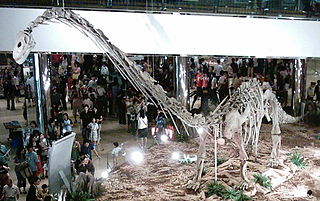
Omeisaurus is a genus of sauropod dinosaur from the Middle Jurassic Period of what is now China. Its name comes from Mount Emei, where it was discovered in the lower Shaximiao Formation of Sichuan Province.
Bashunosaurus is a genus of potentially macronarian sauropod dinosaur from the Middle Jurassic Shaximiao Formation of Kaijiang, China. The type and only species is Bashunosaurus kaijiangensis.
Daanosaurus was a genus of dinosaur. It was a sauropod which lived during the Late Jurassic. It lived in what is now China, and was similar to Bellusaurus.
Gongxianosaurus is a genus of basal sauropod dinosaur from the early Jurassic Period. The only species is Gongxianosaurus shibeiensis. Based on four fragmentary to complete specimens found in China, it is one of the most completely known early sauropods. The skeleton is known in large part, missing both the hand and the majority of the skull. Gongxianosaurus was firstly named and described in a short note published in 1998; however, a comprehensive description has yet to be published. Gongxianosaurus shibeiensis was named for the place it was found, near the village Shibei in Gong County.

Klamelisaurus is a genus of herbivorous sauropod dinosaur from the Middle Jurassic Shishugou Formation of China. The type species is Klamelisaurus gobiensis, which was named by Zhao Xijin in 1993, based on a partial skeleton discovered in 1982 near the abandoned town of Jiangjunmiao. Zhao described Klamelisaurus as the only member of a new subfamily, Klamelisaurinae, among the now-defunct primitive sauropod order Bothrosauropodoidea. Since Zhao's description, Klamelisaurus received limited attention from researchers until Andrew Moore and colleagues redescribed it in 2020.
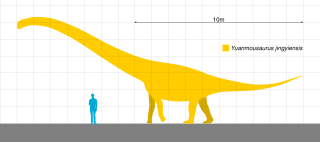
Yuanmousaurus was a sauropod dinosaur from the Middle Jurassic period of China. It is known from incomplete remains, recovered in 2000 from the Zhanghe Formation in Yuanmou County in Yunnan Province. Yuanmousaurus was a relatively large sauropod and may have reached about 17 meters (56 ft) in length. It was a basal member of the Sauropoda, but its exact systematic position is unclear. A recent study placed Yuanmousaurus within the family Mamenchisauridae. It may be a dubious genus. The only and type species was Yuanmousaurus jiangyiensis.

The Shaximiao Formation is a Middle to Late Jurassic aged geological formation in Sichuan, China, most notable for the wealth of dinosaurs fossils that have been excavated from its strata. The Shaximiao Formation is exposed in and around the small township of Dashanpu, situated seven kilometres north-east from Sichuan's third largest city, Zigong, in the Da'an District.
The Ziliujing Formation is a geological formation in China, It is Early Jurassic in age. It is part of the stratigraphy of the Sichuan Basin. The dinosaur Gongxianosaurus and indeterminate theropod material are known from the Dongyuemiao Member of the formation, as well as dinosaur footprints, Zizhongosaurus and indeterminate prosauropods from the Da'anzhai Member. The basal sauropod Sanpasaurus is known from the Maanshan Member. An unnamed stegosaur and the pliosauroid plesiosaur Sinopliosaurus are also known from this formation but they were found an indeterminate member. An unnamed teleosaurid known from a complete skull has also been found in the formation, pending a formal description. The deposition environment during the Da'anzhai Member in the lower Toarcian is thought to have been that of a giant freshwater lake encompassing the whole of the Sichuan basin, around 3 times larger than Lake Superior, coeval with the Toarcian Oceanic Anoxic Event around 183 Ma.
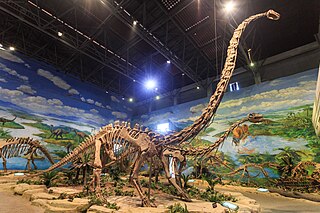
Mamenchisauridae is a family of sauropod dinosaurs belonging to Eusauropoda known from the Jurassic and Early Cretaceous of Asia and Africa. Some members of the group reached gigantic sizes, amongst the largest of all sauropods.
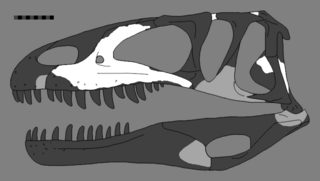
Leshansaurus is a genus of theropod dinosaur from the Late Jurassic Shaximiao Formation of what is now China. It was described in 2009 by a team of Chinese paleontologists. The type species is Leshansaurus qianweiensis. Fossils of Leshansaurus were discovered in strata from the Shangshaximiao Formation, a formation rich in dinosaur fossils. Li et al. referred this taxon to Sinraptoridae – a group of carnosaurian theropods, but it may belong to Megalosauridae instead.
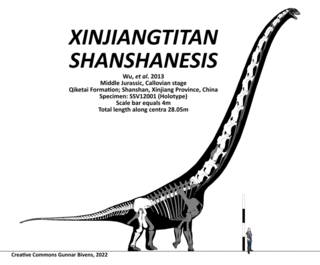
Xinjiangtitan is an extinct genus of mamenchisaurid sauropod that lived during the Middle Jurassic of what is now Xinjiang, northwestern China. Its type and only species is Xinjiangtitan shanshanesis, known from a single incomplete skeleton recovered from the Qiketai Formation. The holotype preserves one of the most complete vertebral columns of any sauropod found in Asia, and has the longest complete neck known for any animal.
Qijianglong is a genus of herbivorous mamenchisaurid sauropod dinosaur from the Early Cretaceous of China.

Lingwulong is a genus of dicraeosaurid sauropod dinosaur from the Middle Jurassic of what is now Lingwu, Yinchuan, Ningxia, China. The type and only species is L. shenqi, known from several partial skeletons. It is the earliest-aged neosauropod ever discovered, as well as the only definite diplodocoid from east Asia.

Bashanosaurus is an extinct genus of stegosaurian dinosaur from the Middle Jurassic Shaximiao Formation of Yunyang County, China. The genus contains a single species, Bashanosaurus primitivus, known from incomplete skeletons belonging to three individuals. It is one of the basalmost stegosaurs, as well as one of the oldest known stegosaurs, along with Adratiklit, Isaberrysaura, and Thyreosaurus.
Ruixinia is an extinct genus of somphospondylan titanosauriform dinosaur from the Early Cretaceous (Barremian) Yixian Formation of China. The genus contains a single species, Ruixinia zhangi. The Ruixinia holotype is a partial articulated skeleton with the most complete series of caudal vertebrae known from any Asian titanosauriform.
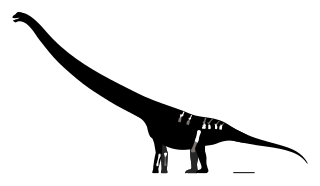
Jingiella is an extinct genus of mamenchisaurid sauropod dinosaur from the Late Jurassic Dongxing Formation of Guangxi, China. The genus contains a single species, J. dongxingensis, known from vertebrae and limb bones. The original description of Jingiella referred to it using the name "Jingia" which was preoccupied by a moth genus named in 1983, and an amendment was published shortly thereafter, establishing Jingiella as the new replacement name.























